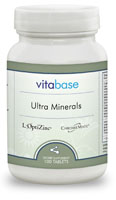| |
Molybdenum supplements |
|
Molybdenum is an essential trace mineral in animal and human nutrition. Molybdenum is involved in the pathways of purine degradation and formation of uric acid. In some animals, adding a small amount of dietary molybdenum enhances growth. In human, molybdenum forms oxides and is a component of a pterin coenzyme essential for the activity of xanthine oxidase, sulfite oxidase, and aldehyde oxidase. Molybdenum is a component of several important interactions that lead to detoxification of the liver. Molybdenum is concentrated primarily in the liver, kidney, bone, and skin. Molybdenum absorption occurs readily in gastrointestinal tract, and excretion occurs primarily via the urine. Beans, beef liver, cereal grains, dark green leafy vegetables, legumes, and peas are all good sources of molybdenum.
|
| |
Biological functions and health benefits of molybdenum |
|
| Molybdenum functions as a cofactor for a number of enzymes that catalyze important chemical transformations in the global carbon,
nitrogen, and sulfur cycles. Molybdenum is the cofactor for human enzymes, including xanthine oxidase, sulfite oxidase, and aldehyde oxidase. In humans, xanthine oxidase is normally found in the liver and not free in the blood. During severe liver damage, xanthine oxidase is released into the blood, so a blood assay for XO is a way to determine if liver damage has happened. Sulfite oxidase is responsible for breaking down sulfites. Sulfite oxidase is also important in the sulfation of various compounds, especially in the brain. This is particularly important, as the brain is often dramatically affected during bouts of chemical sensitivity. In humans, genetic deficiency of sulfite oxidase leads to severe neurological abnormalities, mental retardation and, in several cases, attenuated growth of the brain. Aldehyde oxidase is a molybdenum cofactor-containing soluble enzyme present in the liver and other tissues of several mammalian species. Despite its name, aldehyde oxidase is involved not only in the oxidation of aldehydes to carboxylic acids but also in the oxidation of nitrogen-containing heterocyclic compounds and the reduction of nitro-aromatic compounds, isoxazole, and isothiazole ring systems. Molybdenum is a facilitator of liver detoxification. Molybdenum is involved in breaking down certain amino acids (the building blocks of protein) and the production of waste products for excretion in the urine. It is involved in the chemical reactions that form bone, cartilage and blood. |
| |
Dietary sources of molybdenum |
|
| The amount of molybdenum in plant foods varies significantly and is dependent upon the mineral content of the soil. The more molybdenum in the soil, the higher the content in the crops grown in it. Legumes, such as beans, lentils, grains, and peas, are the richest sources of molybdenum. |
| |
Molybdenum deficiency |
|
Dietary molybdenum deficiency is rare in healthy people. However, if the body does not get enough molybdenum, certain enzymes needed by the body are affected. This may lead to a build up of unwanted substances in some people. In theory, deficiency of the molybdenum cofactor (Moco) causes a severe disease in humans that usually results in premature death in early childhood and is inherited as an autosomal recessive trait.
|
| |
Dosage, intake, recommended daily allowance (RDA) |
|
Because a lack of molybdenum is rare, there is no recommended daily allowance (RDA) for it. A typical supplementary dose is 75 micrograms daily. The following daily intakes are thought to be plenty for most individuals:
Infants birth to 3 years of age: 15 to 50 (mcg).
Children 4 to 6 years of age: 30 to 75 mcg.
Children 7 to 10 years of age: 50 to 150 mcg.
Adolescents and adults: 75 to 250 mcg.
|
| |
Side effects, precautions, toxicity, and drug interactions |
|
Large amounts of molybdenum may cause your body to lose copper. A high intake of molybdenum can alter the activity of alkaline phosphatase. Occasional side effects reported with large doses of this dietary supplement (10-15mg per day) include gout-like symptoms. Molybdenum dusts and molybdenum compounds, such as molybdenum trioxide and water-soluble molybdates, may have slight toxicities if inhaled or ingested orally. Symptoms of molybdenum toxicity include diarrhea, depressed growth rate, and anemia.
|
|
|
|
|
 Minerals are divided into two classes: macrominerals and trace minerals. Macrominerals are needed in larger amounts than trace minerals. Ultra Minerals by Vitabase includes the macrominerals calcium, magnesium and potassium. Important trace minerals in our supplement are iron, iodine, zinc, selenium, copper, manganese, chromium, molybdenum, vanadium and boron. Many of the minerals are chelated which means they have been bonded to a protein molecule. This helps transport them to the blood stream and enhances absorption at the cellular level. Click here for more information.
Minerals are divided into two classes: macrominerals and trace minerals. Macrominerals are needed in larger amounts than trace minerals. Ultra Minerals by Vitabase includes the macrominerals calcium, magnesium and potassium. Important trace minerals in our supplement are iron, iodine, zinc, selenium, copper, manganese, chromium, molybdenum, vanadium and boron. Many of the minerals are chelated which means they have been bonded to a protein molecule. This helps transport them to the blood stream and enhances absorption at the cellular level. Click here for more information.